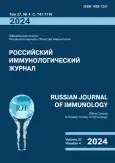Оценка показателей апоптоза у больных атопическим дерматитом
- Авторы: Ревякина В.А.1,2, Мухортых В.А.1,3, Тармаева Н.А.1, Ларькова И.А.1,2
-
Учреждения:
- ФГБУН «Федеральный исследовательский центр питания, биотехнологии и безопасности пищи»
- ФГАУ «Национальный медицинский исследовательский центр здоровья детей» Министерства здравоохранения РФ
- ФГБУ «Федеральный научно-клинический центр детей и подростков Федерального медико-биологического агентства России»
- Выпуск: Том 27, № 4 (2024)
- Страницы: 775-780
- Раздел: КРАТКИЕ СООБЩЕНИЯ
- URL: https://journal-vniispk.ru/1028-7221/article/view/267850
- DOI: https://doi.org/10.46235/1028-7221-16943-EOA
- ID: 267850
Цитировать
Полный текст
Аннотация
Исследование нацелено на изучение изменений в процессах апоптоза у пациентов, страдающих атопическим дерматитом (АтД). В ходе работы была проанализирована группа из 88 пациентов в возрастном диапазоне от одного года до трех лет, у которых наблюдались разнообразные степени тяжести данного заболевания. Показатели SCORAD, отражающие степень тяжести АтД, демонстрировали следующие значения: 68,14±2,63 при тяжелой форме, 32,03±1,43 при средней и 12,12±1,43 при легкой. В рамках исследования для определения уровней маркеров апоптоза в крови (включая Caspase 8, Caspase 9, sCD153, sFas-L, Annexin 5) использовался иммуноферментный анализ (ELISA) с применением наборов от Bender MedSystems® (Австрия). Анализ показал значительное уменьшение концентрации Annexin 5 в сыворотке крови у пациентов с АтД в двадцать раз по сравнению с контрольными значениями, что говорит о заметном нарушении процессов апоптоза (p < 0,05). Кроме того, было обнаружено статистически значимое снижение уровней Caspase 8 и Caspase 9, где концентрация Caspase 8 уменьшилась втрое, а Caspase 9 – в восемь раз по сравнению с нормативными показателями. При этом уровни sFas-L также продемонстрировали существенное снижение. В отличие от этих показателей, содержание sCD153 в сыворотке крови оказалось значительно выше (в пять раз) нормы, что не характерно для здорового состояния. Особенно ярко выраженные отклонения в процессах апоптоза наблюдались у пациентов с тяжелыми формами атопического дерматита, подчеркивая тесную связь между уровнем нарушений апоптоза и тяжестью клинических проявлений заболевания. Это исследование подтверждает необходимость более глубокого анализа механизмов апоптоза в контексте АтД, указывая на комплексные изменения в сигнальных путях активации и нарушения элиминации альтерированных иммунных клеток, способствующих усилению и хронизации воспалительного процесса в коже.
Полный текст
Открыть статью на сайте журналаОб авторах
В. А. Ревякина
ФГБУН «Федеральный исследовательский центр питания, биотехнологии и безопасности пищи»; ФГАУ «Национальный медицинский исследовательский центр здоровья детей» Министерства здравоохранения РФ
Автор, ответственный за переписку.
Email: 5356797@mail.ru
д.м.н., профессор, заведующая отделением ФГБУН «Федеральный исследовательский центр питания, биотехнологии и безопасности пищи»; ведущий научный сотрудник ФГАУ «Национальный медицинский исследовательский центр здоровья детей» Министерства здравоохранения РФ
Россия, Москва; МоскваВ. А. Мухортых
ФГБУН «Федеральный исследовательский центр питания, биотехнологии и безопасности пищи»; ФГБУ «Федеральный научно-клинический центр детей и подростков Федерального медико-биологического агентства России»
Email: 5356797@mail.ru
к.м.н., научный сотрудник ФГБУН «Федеральный исследовательский центр питания, биотехнологии и безопасности пищи»; врач – аллерголог-иммунолог ФГБУ «Федеральный научно-клинический центр детей и подростков Федерального медико-биологического агентства России»
Россия, Москва; МоскваН. А. Тармаева
ФГБУН «Федеральный исследовательский центр питания, биотехнологии и безопасности пищи»
Email: 5356797@mail.ru
младший научный сотрудник
Россия, МоскваИ. А. Ларькова
ФГБУН «Федеральный исследовательский центр питания, биотехнологии и безопасности пищи»; ФГАУ «Национальный медицинский исследовательский центр здоровья детей» Министерства здравоохранения РФ
Email: 5356797@mail.ru
к.м.н., старший научный сотрудник ФГБУН «Федеральный исследовательский центр питания, биотехнологии и безопасности пищи»; старший научный сотрудник ФГАУ «Национальный медицинский исследовательский центр здоровья детей» Министерства здравоохранения РФ
Россия, Москва; МоскваСписок литературы
- Глухова Е.А., Мухортых В.А., Тамразова ОБ., Таганов А.В., Ревякина В.А. Предикторы тяжелого течения атопического дерматита // Вопросы питания, 2022. Т 91, № 1. С. 76-85. [Glukhova E.A., Mukhortykh V.A., Tamrazova O.B., Taganov A.V., Revyakina V.A. Predictors of severe course of atopic dermatitis. Voprosy Pitaniya = Nutrition Issues, 2022, Vol. 91, no. 1, pp. 76-85. (In Russ.)]
- Ларькова И.А., Глухова Е.А., Ревякина В.А. Эффективность и безопасность иммунобиологической терапии атопического дерматита у детей // Российский педиатрический журнал, 2022. Т. 25, № 1. С. 46-51. [Larkova I.A., Glukhova E.A., Revyakina V.A. Effectiveness and safety of immunobiological therapy for atopic dermatitis in children. Rossiyskiy pediatricheskiy zhurnal = Russian Pediatric Journal, 2022, Vol. 25, no. 1, pp. 46-51. (In Russ.)]
- Alshiraihi I., Kato T.A. Apoptosis Detection Assays. Methods Mol. Biol., 2023, Vol. 2519, pp. 53-63.
- Alyoussef A. Attenuation of experimentally induced atopic dermatitis in mice by sulforaphane: effect on inflammation and apoptosis. Toxicol. Mech. Methods, 2022, Vol. 32, no. 3, pp. 224-232.
- James B.N., Oyeniran C., Sturgill J.L., Newton J., Martin R.K., Bieberich E., Spiegel, S. Ceramide in apoptosis and oxidative stress in allergic inflammation and asthma. J. Allergy Clin. Immunol., 2021, Vol. 147, no. 5, pp. 1936-1948.
- Jing J. The Relevance, Predictability, and Utility of Annexin A5 for Human Physiopathology. Int. J. Mol. Sci., 2024, Vol. 25, no. 5, 2865. doi: 10.3390/ijms25052865.
- Mao M.G., Xu J., Liu R.T., Ye L., Wang R., Jiang J.L. Fas/FasL of pacific cod mediated apoptosis. Dev. Comp. Immunol., 2021, Vol. 119, 104022. doi: 10.1016/j.dci.2021.104022.
- Niles A.L., Kupcho K.R. A Nondestructive, Real-Time Annexin V Apoptosis Assay. Methods Mol. Biol., 2022, Vol. 2543, pp. 1-11.
- Obeng E. Apoptosis (programmed cell death) and its signals – A review. Braz. J. Biol., 2021, Vol. 81, no. 4, pp. 1133-1143.
- Severity scoring of atopic dermatitis: the SCORAD index. Consensus Report of the European Task Force on Atopic Dermatitis. Dermatology, 1993, Vol. 186, no. 1, pp. 23-31.
- Sroka-Tomaszewska J., Trzeciak, M. Molecular Mechanisms of Atopic Dermatitis Pathogenesis. Int. J. Mol. Sci., 2021, Vol. 22, 4130. doi: 10.3390/ijms22084130.
- Szymański U., Cios A., Ciepielak M., Stankiewicz W. Cytokines and apoptosis in atopic dermatitis. Postepy Dermatol. Alergol., 2021, Vol. 38, no. 2, pp. 1-13.
- Trautmann A, Akdis M, Klunker S, Blaser K, Akdis CA. Role of apoptosis in atopic dermatitis. Int. Arch. Allergy Immunol., 2001, Vol. 124, no. 1-3, pp. 230-232.
Дополнительные файлы








